Strategic Analysis of Toyota Australia
VerifiedAdded on 2023/06/08
|16
|3303
|227
AI Summary
This report investigates the internal and external environments of Toyota Australia, analysing the PESTLE and Porter Five Force analysis. It also highlights the internal environment of Toyota and provides recommendations to improve the business strategy.
Contribute Materials
Your contribution can guide someone’s learning journey. Share your
documents today.
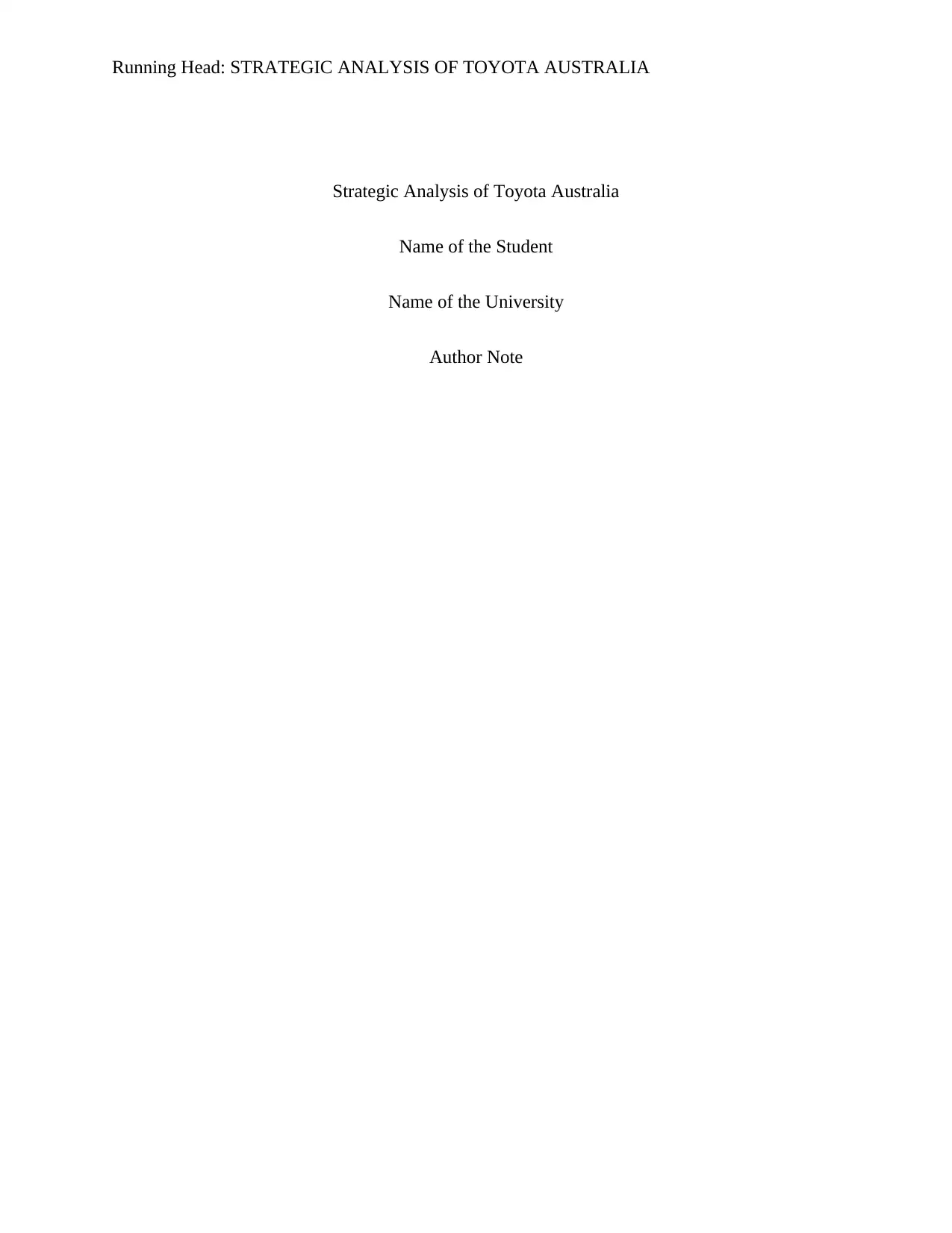
Running Head: STRATEGIC ANALYSIS OF TOYOTA AUSTRALIA
Strategic Analysis of Toyota Australia
Name of the Student
Name of the University
Author Note
Strategic Analysis of Toyota Australia
Name of the Student
Name of the University
Author Note
Secure Best Marks with AI Grader
Need help grading? Try our AI Grader for instant feedback on your assignments.
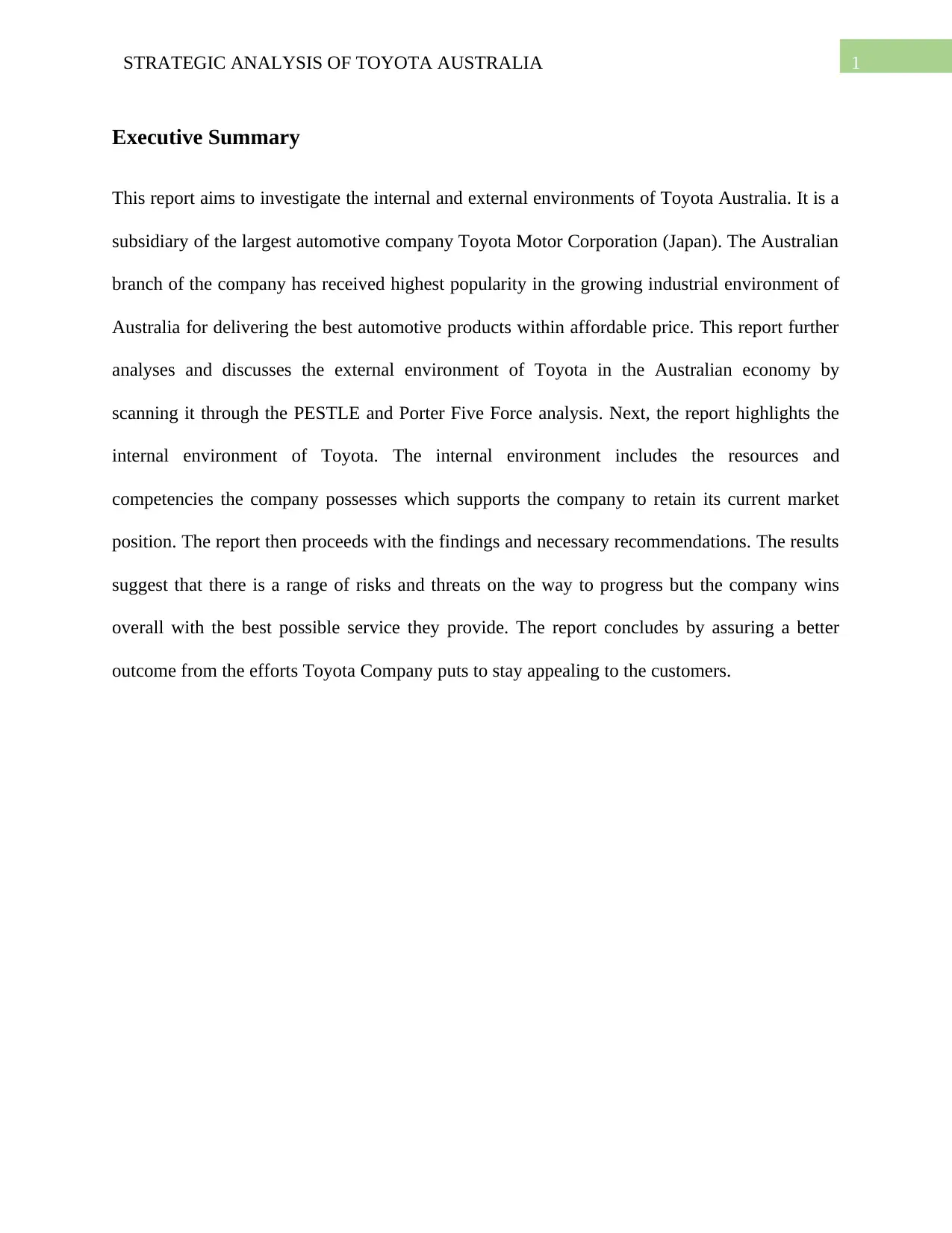
1STRATEGIC ANALYSIS OF TOYOTA AUSTRALIA
Executive Summary
This report aims to investigate the internal and external environments of Toyota Australia. It is a
subsidiary of the largest automotive company Toyota Motor Corporation (Japan). The Australian
branch of the company has received highest popularity in the growing industrial environment of
Australia for delivering the best automotive products within affordable price. This report further
analyses and discusses the external environment of Toyota in the Australian economy by
scanning it through the PESTLE and Porter Five Force analysis. Next, the report highlights the
internal environment of Toyota. The internal environment includes the resources and
competencies the company possesses which supports the company to retain its current market
position. The report then proceeds with the findings and necessary recommendations. The results
suggest that there is a range of risks and threats on the way to progress but the company wins
overall with the best possible service they provide. The report concludes by assuring a better
outcome from the efforts Toyota Company puts to stay appealing to the customers.
Executive Summary
This report aims to investigate the internal and external environments of Toyota Australia. It is a
subsidiary of the largest automotive company Toyota Motor Corporation (Japan). The Australian
branch of the company has received highest popularity in the growing industrial environment of
Australia for delivering the best automotive products within affordable price. This report further
analyses and discusses the external environment of Toyota in the Australian economy by
scanning it through the PESTLE and Porter Five Force analysis. Next, the report highlights the
internal environment of Toyota. The internal environment includes the resources and
competencies the company possesses which supports the company to retain its current market
position. The report then proceeds with the findings and necessary recommendations. The results
suggest that there is a range of risks and threats on the way to progress but the company wins
overall with the best possible service they provide. The report concludes by assuring a better
outcome from the efforts Toyota Company puts to stay appealing to the customers.
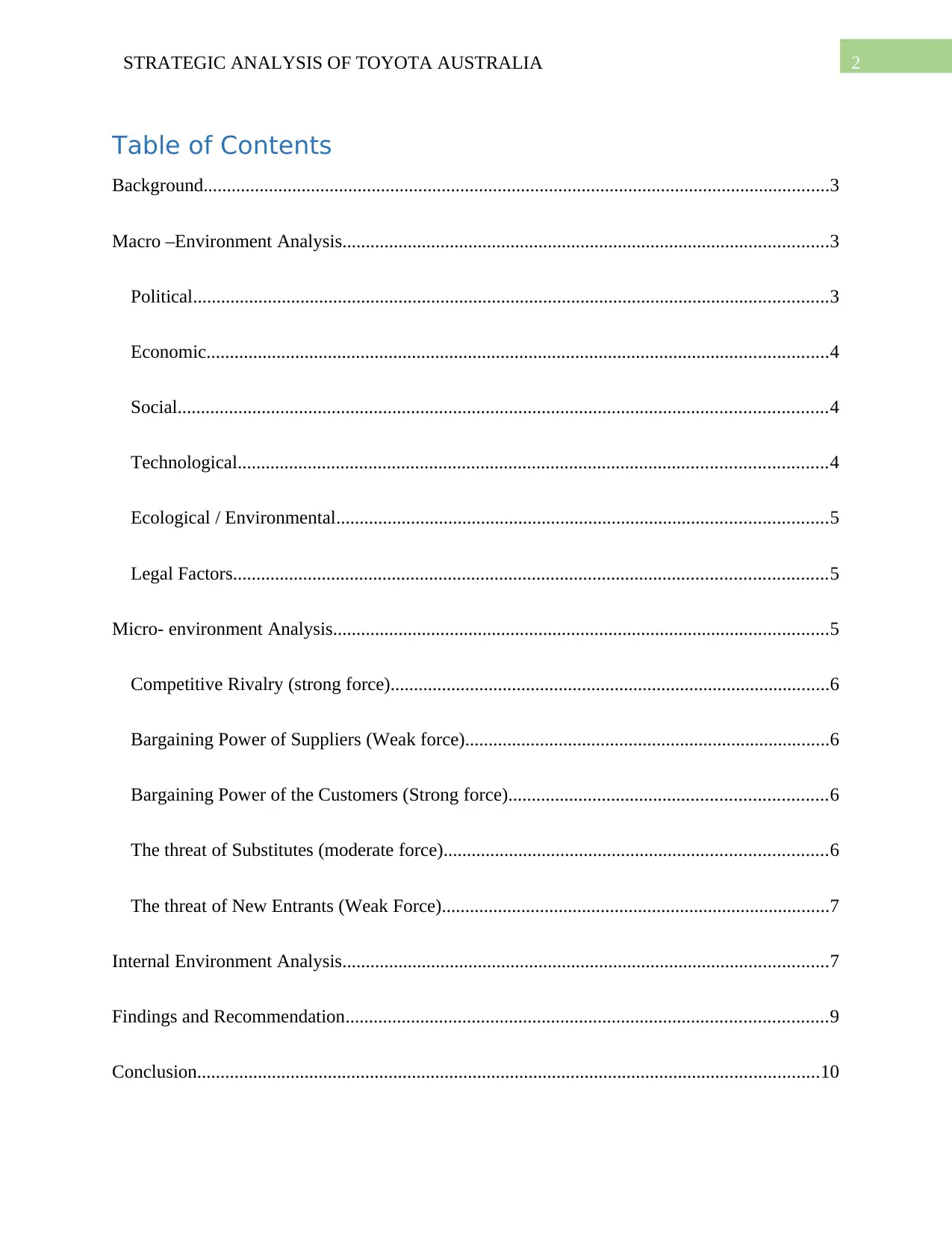
2STRATEGIC ANALYSIS OF TOYOTA AUSTRALIA
Table of Contents
Background......................................................................................................................................3
Macro –Environment Analysis........................................................................................................3
Political........................................................................................................................................3
Economic.....................................................................................................................................4
Social...........................................................................................................................................4
Technological..............................................................................................................................4
Ecological / Environmental.........................................................................................................5
Legal Factors...............................................................................................................................5
Micro- environment Analysis..........................................................................................................5
Competitive Rivalry (strong force)..............................................................................................6
Bargaining Power of Suppliers (Weak force)..............................................................................6
Bargaining Power of the Customers (Strong force)....................................................................6
The threat of Substitutes (moderate force)..................................................................................6
The threat of New Entrants (Weak Force)...................................................................................7
Internal Environment Analysis........................................................................................................7
Findings and Recommendation.......................................................................................................9
Conclusion.....................................................................................................................................10
Table of Contents
Background......................................................................................................................................3
Macro –Environment Analysis........................................................................................................3
Political........................................................................................................................................3
Economic.....................................................................................................................................4
Social...........................................................................................................................................4
Technological..............................................................................................................................4
Ecological / Environmental.........................................................................................................5
Legal Factors...............................................................................................................................5
Micro- environment Analysis..........................................................................................................5
Competitive Rivalry (strong force)..............................................................................................6
Bargaining Power of Suppliers (Weak force)..............................................................................6
Bargaining Power of the Customers (Strong force)....................................................................6
The threat of Substitutes (moderate force)..................................................................................6
The threat of New Entrants (Weak Force)...................................................................................7
Internal Environment Analysis........................................................................................................7
Findings and Recommendation.......................................................................................................9
Conclusion.....................................................................................................................................10
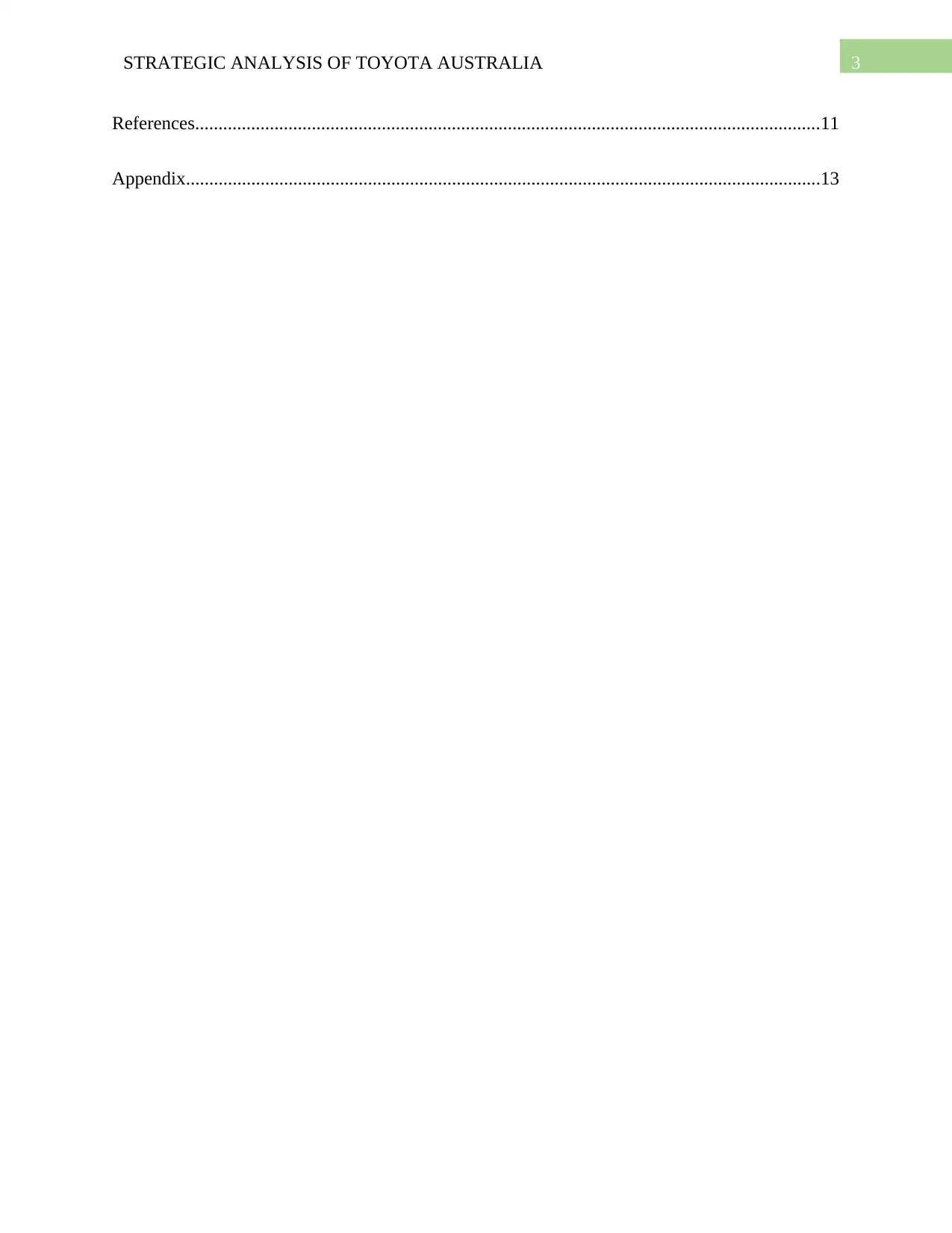
3STRATEGIC ANALYSIS OF TOYOTA AUSTRALIA
References......................................................................................................................................11
Appendix........................................................................................................................................13
References......................................................................................................................................11
Appendix........................................................................................................................................13
Secure Best Marks with AI Grader
Need help grading? Try our AI Grader for instant feedback on your assignments.
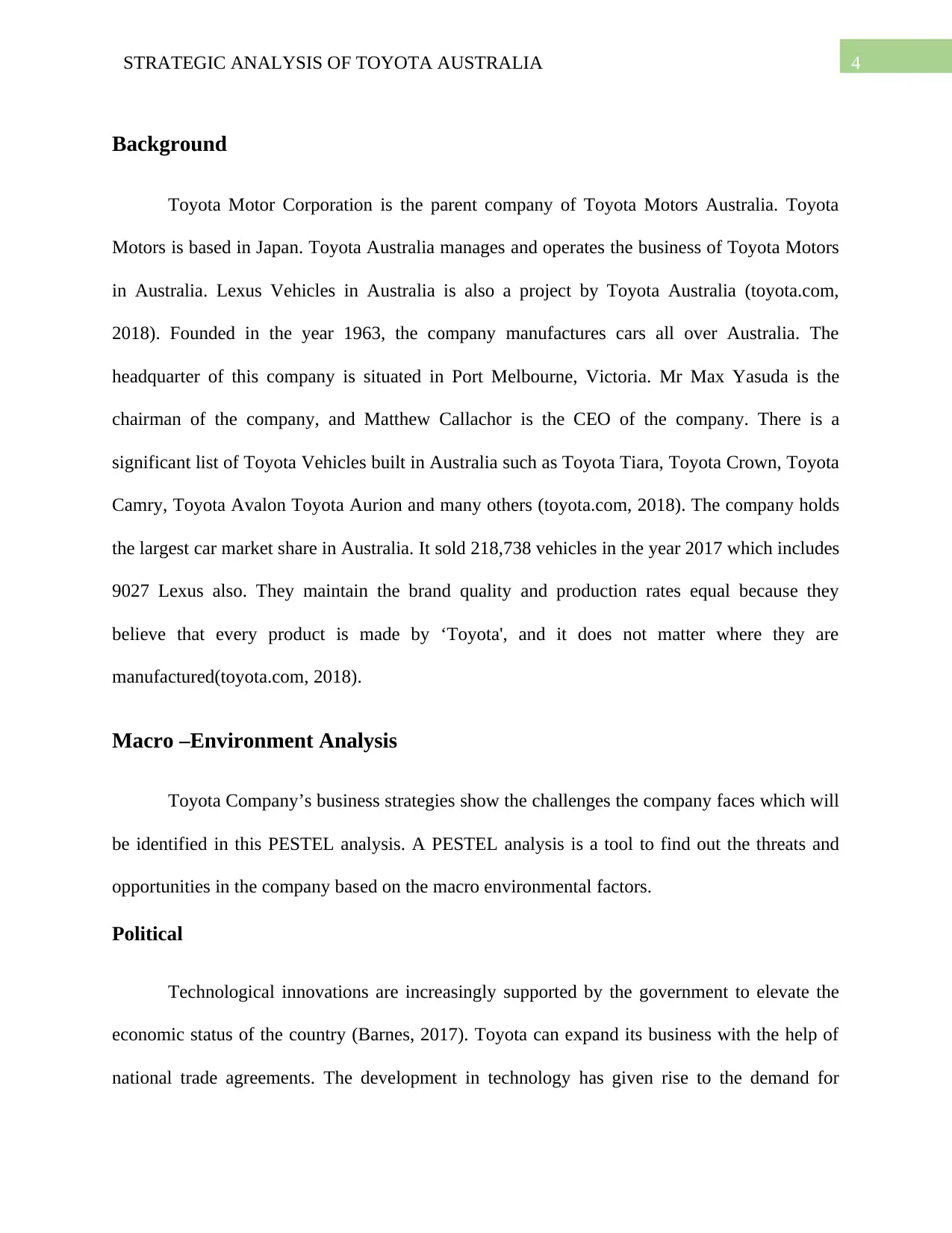
4STRATEGIC ANALYSIS OF TOYOTA AUSTRALIA
Background
Toyota Motor Corporation is the parent company of Toyota Motors Australia. Toyota
Motors is based in Japan. Toyota Australia manages and operates the business of Toyota Motors
in Australia. Lexus Vehicles in Australia is also a project by Toyota Australia (toyota.com,
2018). Founded in the year 1963, the company manufactures cars all over Australia. The
headquarter of this company is situated in Port Melbourne, Victoria. Mr Max Yasuda is the
chairman of the company, and Matthew Callachor is the CEO of the company. There is a
significant list of Toyota Vehicles built in Australia such as Toyota Tiara, Toyota Crown, Toyota
Camry, Toyota Avalon Toyota Aurion and many others (toyota.com, 2018). The company holds
the largest car market share in Australia. It sold 218,738 vehicles in the year 2017 which includes
9027 Lexus also. They maintain the brand quality and production rates equal because they
believe that every product is made by ‘Toyota', and it does not matter where they are
manufactured(toyota.com, 2018).
Macro –Environment Analysis
Toyota Company’s business strategies show the challenges the company faces which will
be identified in this PESTEL analysis. A PESTEL analysis is a tool to find out the threats and
opportunities in the company based on the macro environmental factors.
Political
Technological innovations are increasingly supported by the government to elevate the
economic status of the country (Barnes, 2017). Toyota can expand its business with the help of
national trade agreements. The development in technology has given rise to the demand for
Background
Toyota Motor Corporation is the parent company of Toyota Motors Australia. Toyota
Motors is based in Japan. Toyota Australia manages and operates the business of Toyota Motors
in Australia. Lexus Vehicles in Australia is also a project by Toyota Australia (toyota.com,
2018). Founded in the year 1963, the company manufactures cars all over Australia. The
headquarter of this company is situated in Port Melbourne, Victoria. Mr Max Yasuda is the
chairman of the company, and Matthew Callachor is the CEO of the company. There is a
significant list of Toyota Vehicles built in Australia such as Toyota Tiara, Toyota Crown, Toyota
Camry, Toyota Avalon Toyota Aurion and many others (toyota.com, 2018). The company holds
the largest car market share in Australia. It sold 218,738 vehicles in the year 2017 which includes
9027 Lexus also. They maintain the brand quality and production rates equal because they
believe that every product is made by ‘Toyota', and it does not matter where they are
manufactured(toyota.com, 2018).
Macro –Environment Analysis
Toyota Company’s business strategies show the challenges the company faces which will
be identified in this PESTEL analysis. A PESTEL analysis is a tool to find out the threats and
opportunities in the company based on the macro environmental factors.
Political
Technological innovations are increasingly supported by the government to elevate the
economic status of the country (Barnes, 2017). Toyota can expand its business with the help of
national trade agreements. The development in technology has given rise to the demand for
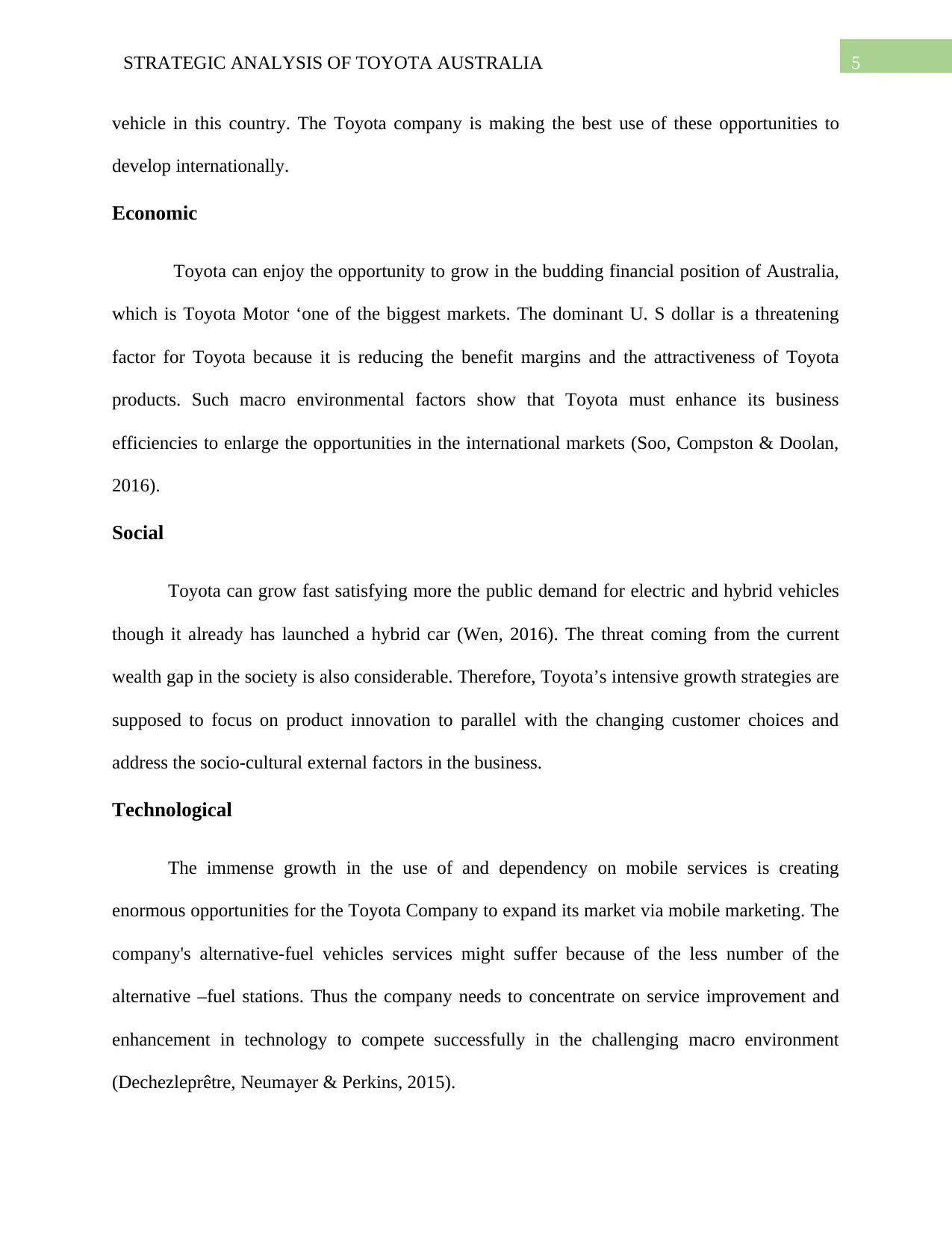
5STRATEGIC ANALYSIS OF TOYOTA AUSTRALIA
vehicle in this country. The Toyota company is making the best use of these opportunities to
develop internationally.
Economic
Toyota can enjoy the opportunity to grow in the budding financial position of Australia,
which is Toyota Motor ‘one of the biggest markets. The dominant U. S dollar is a threatening
factor for Toyota because it is reducing the benefit margins and the attractiveness of Toyota
products. Such macro environmental factors show that Toyota must enhance its business
efficiencies to enlarge the opportunities in the international markets (Soo, Compston & Doolan,
2016).
Social
Toyota can grow fast satisfying more the public demand for electric and hybrid vehicles
though it already has launched a hybrid car (Wen, 2016). The threat coming from the current
wealth gap in the society is also considerable. Therefore, Toyota’s intensive growth strategies are
supposed to focus on product innovation to parallel with the changing customer choices and
address the socio-cultural external factors in the business.
Technological
The immense growth in the use of and dependency on mobile services is creating
enormous opportunities for the Toyota Company to expand its market via mobile marketing. The
company's alternative-fuel vehicles services might suffer because of the less number of the
alternative –fuel stations. Thus the company needs to concentrate on service improvement and
enhancement in technology to compete successfully in the challenging macro environment
(Dechezleprêtre, Neumayer & Perkins, 2015).
vehicle in this country. The Toyota company is making the best use of these opportunities to
develop internationally.
Economic
Toyota can enjoy the opportunity to grow in the budding financial position of Australia,
which is Toyota Motor ‘one of the biggest markets. The dominant U. S dollar is a threatening
factor for Toyota because it is reducing the benefit margins and the attractiveness of Toyota
products. Such macro environmental factors show that Toyota must enhance its business
efficiencies to enlarge the opportunities in the international markets (Soo, Compston & Doolan,
2016).
Social
Toyota can grow fast satisfying more the public demand for electric and hybrid vehicles
though it already has launched a hybrid car (Wen, 2016). The threat coming from the current
wealth gap in the society is also considerable. Therefore, Toyota’s intensive growth strategies are
supposed to focus on product innovation to parallel with the changing customer choices and
address the socio-cultural external factors in the business.
Technological
The immense growth in the use of and dependency on mobile services is creating
enormous opportunities for the Toyota Company to expand its market via mobile marketing. The
company's alternative-fuel vehicles services might suffer because of the less number of the
alternative –fuel stations. Thus the company needs to concentrate on service improvement and
enhancement in technology to compete successfully in the challenging macro environment
(Dechezleprêtre, Neumayer & Perkins, 2015).
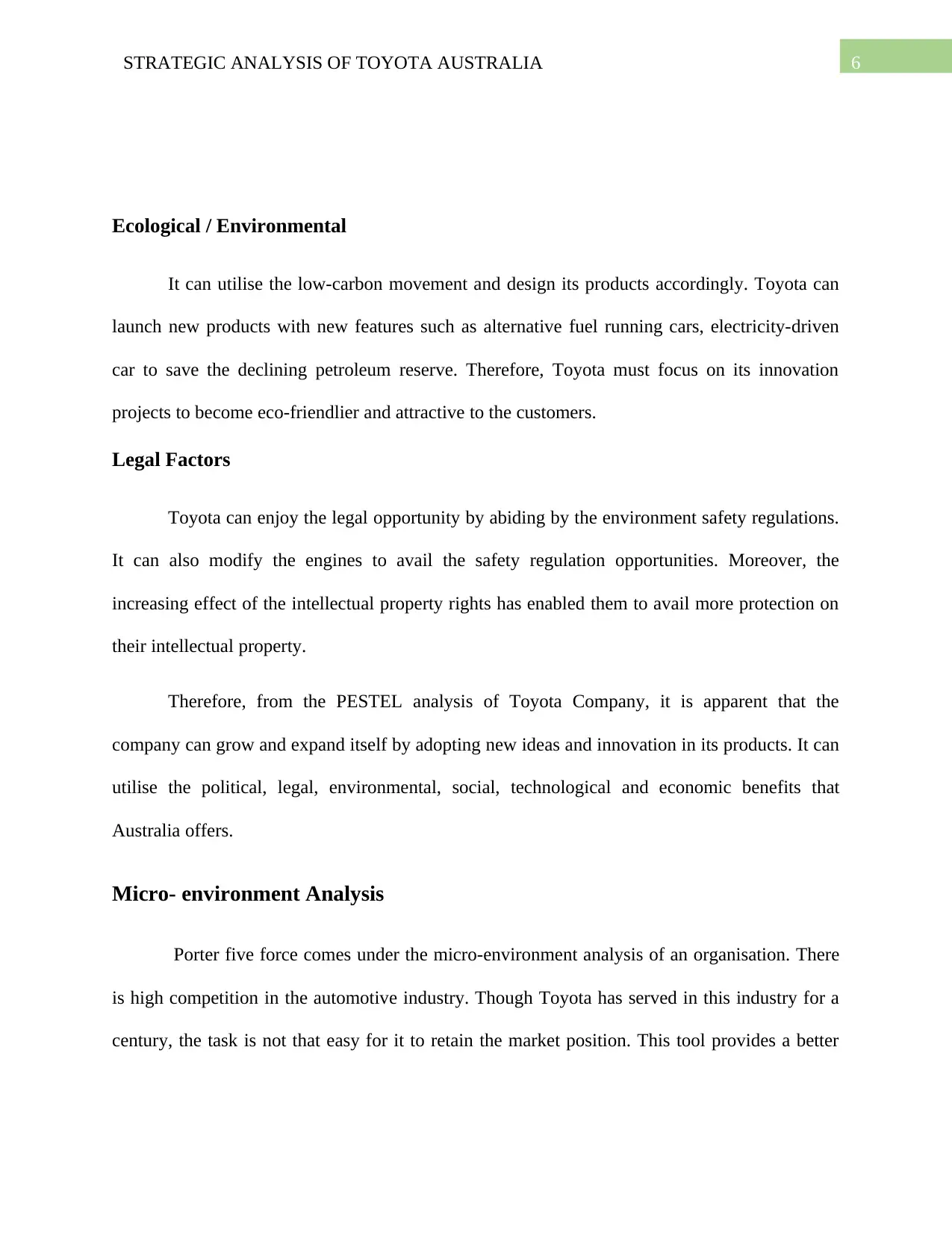
6STRATEGIC ANALYSIS OF TOYOTA AUSTRALIA
Ecological / Environmental
It can utilise the low-carbon movement and design its products accordingly. Toyota can
launch new products with new features such as alternative fuel running cars, electricity-driven
car to save the declining petroleum reserve. Therefore, Toyota must focus on its innovation
projects to become eco-friendlier and attractive to the customers.
Legal Factors
Toyota can enjoy the legal opportunity by abiding by the environment safety regulations.
It can also modify the engines to avail the safety regulation opportunities. Moreover, the
increasing effect of the intellectual property rights has enabled them to avail more protection on
their intellectual property.
Therefore, from the PESTEL analysis of Toyota Company, it is apparent that the
company can grow and expand itself by adopting new ideas and innovation in its products. It can
utilise the political, legal, environmental, social, technological and economic benefits that
Australia offers.
Micro- environment Analysis
Porter five force comes under the micro-environment analysis of an organisation. There
is high competition in the automotive industry. Though Toyota has served in this industry for a
century, the task is not that easy for it to retain the market position. This tool provides a better
Ecological / Environmental
It can utilise the low-carbon movement and design its products accordingly. Toyota can
launch new products with new features such as alternative fuel running cars, electricity-driven
car to save the declining petroleum reserve. Therefore, Toyota must focus on its innovation
projects to become eco-friendlier and attractive to the customers.
Legal Factors
Toyota can enjoy the legal opportunity by abiding by the environment safety regulations.
It can also modify the engines to avail the safety regulation opportunities. Moreover, the
increasing effect of the intellectual property rights has enabled them to avail more protection on
their intellectual property.
Therefore, from the PESTEL analysis of Toyota Company, it is apparent that the
company can grow and expand itself by adopting new ideas and innovation in its products. It can
utilise the political, legal, environmental, social, technological and economic benefits that
Australia offers.
Micro- environment Analysis
Porter five force comes under the micro-environment analysis of an organisation. There
is high competition in the automotive industry. Though Toyota has served in this industry for a
century, the task is not that easy for it to retain the market position. This tool provides a better
Paraphrase This Document
Need a fresh take? Get an instant paraphrase of this document with our AI Paraphraser

7STRATEGIC ANALYSIS OF TOYOTA AUSTRALIA
insight into the company's micro environment, who the competitors are, what are the bargaining
powers and many other aspects.
Competitive Rivalry (strong force)
In the growing competitive automotive industry, firms prefer to compete rather than exist.
The number of rivals has grown with the passage of time and Ford, Suzuki, Mercedes, BMW are
the toughest ones. In order to sustain in this highly competitive market, technological innovation
and high-quality marketing strategy are mandatory. Therefore, the company must take its
competitors seriously.
Bargaining Power of Suppliers (Weak force)
The suppliers in any industry aim at influencing the firm to advance their business. It is
the case with almost all brands, but the situation with Toyota is different. There are plenty of
good suppliers in the market which supports the availability of the products reducing the
bargaining power of the suppliers. The Company, therefore, should utilise the availability of the
suppliers.
Bargaining Power of the Customers (Strong force)
Since there are so many competitors and substitute products are available in the market,
the bargaining power of the customers are high and considered to be a potent force for
Toyota(toyota.com, 2018). However, the quality of the products manufactured by Toyota
Company cannot be questioned, but the switching costs are low means the customers can switch
insight into the company's micro environment, who the competitors are, what are the bargaining
powers and many other aspects.
Competitive Rivalry (strong force)
In the growing competitive automotive industry, firms prefer to compete rather than exist.
The number of rivals has grown with the passage of time and Ford, Suzuki, Mercedes, BMW are
the toughest ones. In order to sustain in this highly competitive market, technological innovation
and high-quality marketing strategy are mandatory. Therefore, the company must take its
competitors seriously.
Bargaining Power of Suppliers (Weak force)
The suppliers in any industry aim at influencing the firm to advance their business. It is
the case with almost all brands, but the situation with Toyota is different. There are plenty of
good suppliers in the market which supports the availability of the products reducing the
bargaining power of the suppliers. The Company, therefore, should utilise the availability of the
suppliers.
Bargaining Power of the Customers (Strong force)
Since there are so many competitors and substitute products are available in the market,
the bargaining power of the customers are high and considered to be a potent force for
Toyota(toyota.com, 2018). However, the quality of the products manufactured by Toyota
Company cannot be questioned, but the switching costs are low means the customers can switch
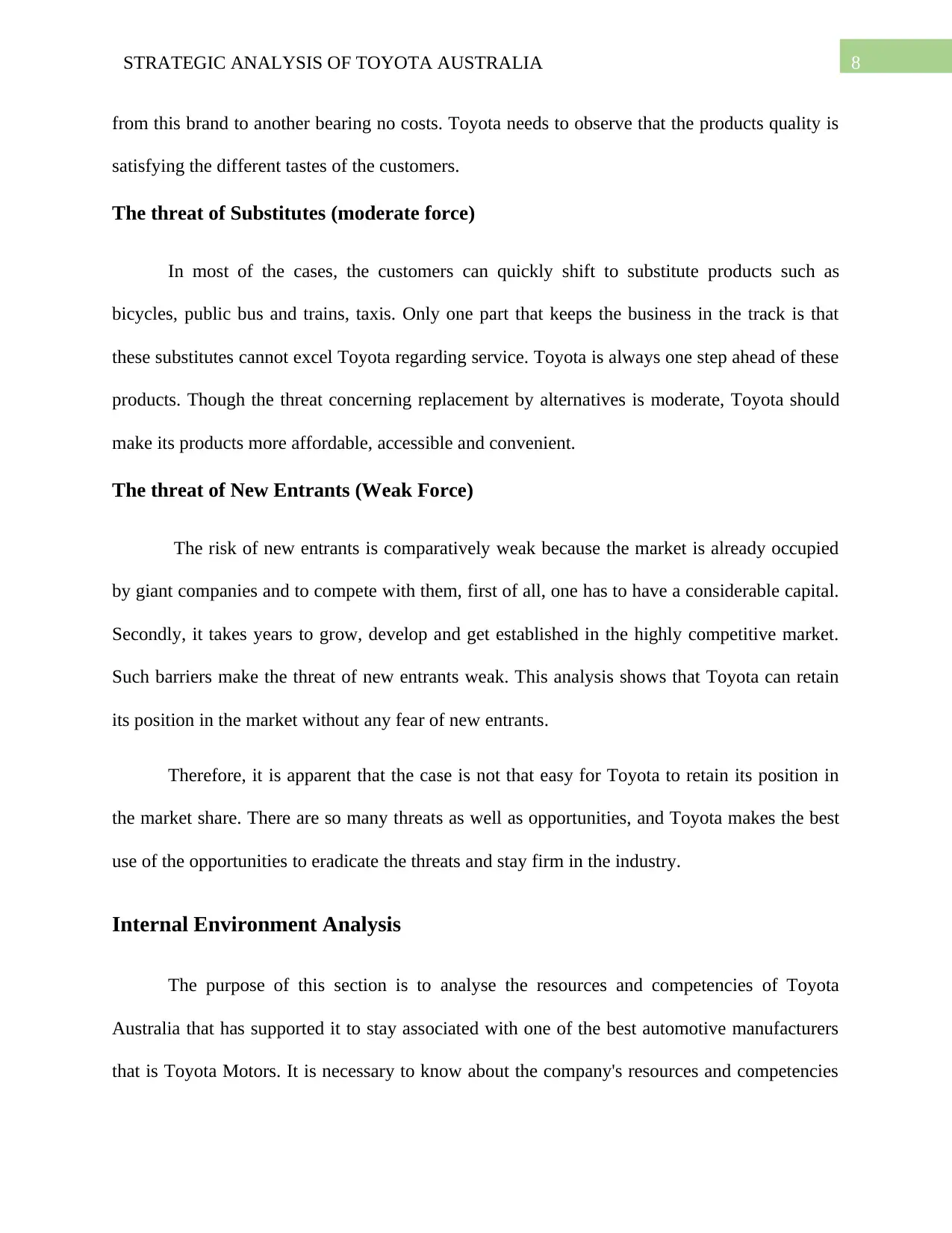
8STRATEGIC ANALYSIS OF TOYOTA AUSTRALIA
from this brand to another bearing no costs. Toyota needs to observe that the products quality is
satisfying the different tastes of the customers.
The threat of Substitutes (moderate force)
In most of the cases, the customers can quickly shift to substitute products such as
bicycles, public bus and trains, taxis. Only one part that keeps the business in the track is that
these substitutes cannot excel Toyota regarding service. Toyota is always one step ahead of these
products. Though the threat concerning replacement by alternatives is moderate, Toyota should
make its products more affordable, accessible and convenient.
The threat of New Entrants (Weak Force)
The risk of new entrants is comparatively weak because the market is already occupied
by giant companies and to compete with them, first of all, one has to have a considerable capital.
Secondly, it takes years to grow, develop and get established in the highly competitive market.
Such barriers make the threat of new entrants weak. This analysis shows that Toyota can retain
its position in the market without any fear of new entrants.
Therefore, it is apparent that the case is not that easy for Toyota to retain its position in
the market share. There are so many threats as well as opportunities, and Toyota makes the best
use of the opportunities to eradicate the threats and stay firm in the industry.
Internal Environment Analysis
The purpose of this section is to analyse the resources and competencies of Toyota
Australia that has supported it to stay associated with one of the best automotive manufacturers
that is Toyota Motors. It is necessary to know about the company's resources and competencies
from this brand to another bearing no costs. Toyota needs to observe that the products quality is
satisfying the different tastes of the customers.
The threat of Substitutes (moderate force)
In most of the cases, the customers can quickly shift to substitute products such as
bicycles, public bus and trains, taxis. Only one part that keeps the business in the track is that
these substitutes cannot excel Toyota regarding service. Toyota is always one step ahead of these
products. Though the threat concerning replacement by alternatives is moderate, Toyota should
make its products more affordable, accessible and convenient.
The threat of New Entrants (Weak Force)
The risk of new entrants is comparatively weak because the market is already occupied
by giant companies and to compete with them, first of all, one has to have a considerable capital.
Secondly, it takes years to grow, develop and get established in the highly competitive market.
Such barriers make the threat of new entrants weak. This analysis shows that Toyota can retain
its position in the market without any fear of new entrants.
Therefore, it is apparent that the case is not that easy for Toyota to retain its position in
the market share. There are so many threats as well as opportunities, and Toyota makes the best
use of the opportunities to eradicate the threats and stay firm in the industry.
Internal Environment Analysis
The purpose of this section is to analyse the resources and competencies of Toyota
Australia that has supported it to stay associated with one of the best automotive manufacturers
that is Toyota Motors. It is necessary to know about the company's resources and competencies
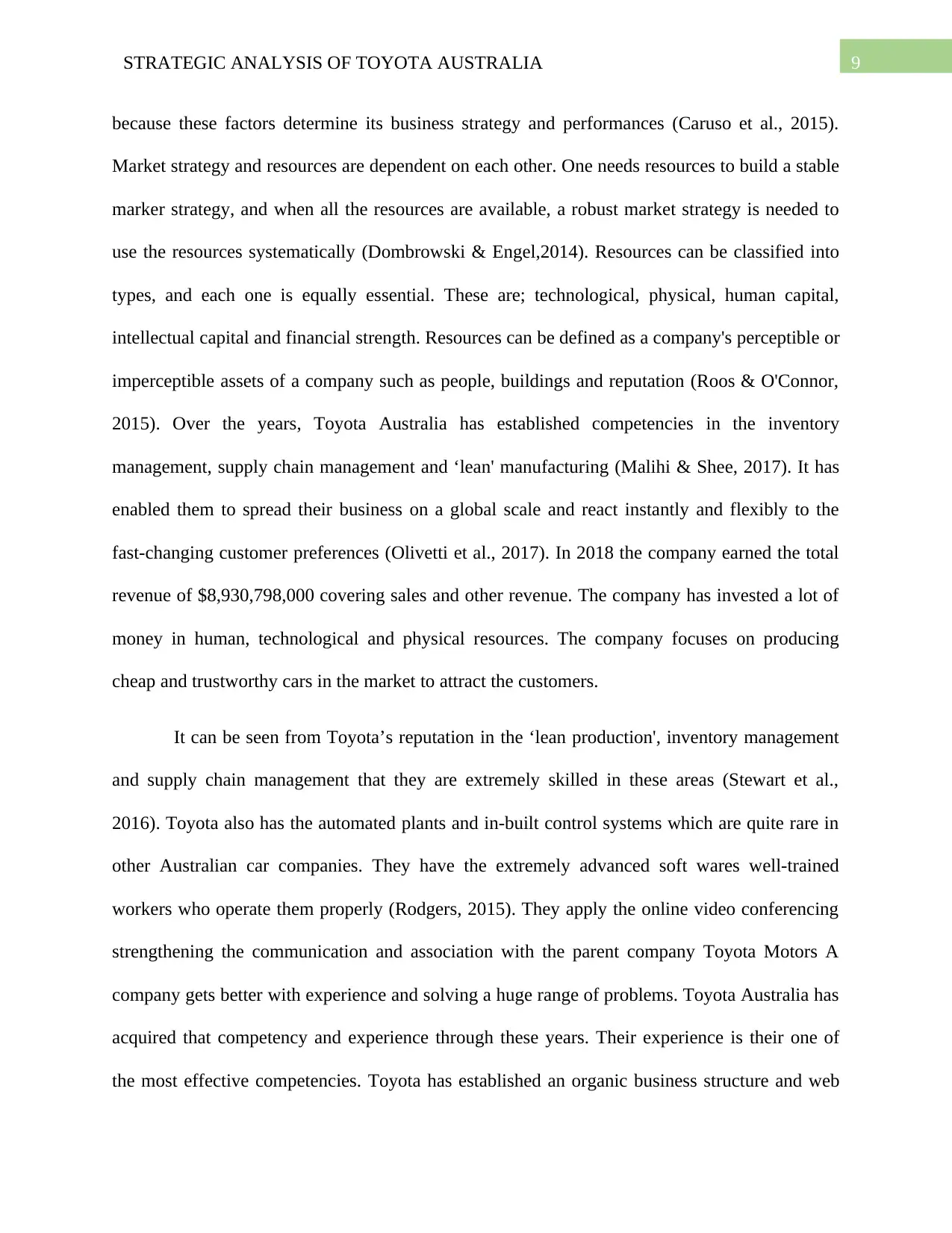
9STRATEGIC ANALYSIS OF TOYOTA AUSTRALIA
because these factors determine its business strategy and performances (Caruso et al., 2015).
Market strategy and resources are dependent on each other. One needs resources to build a stable
marker strategy, and when all the resources are available, a robust market strategy is needed to
use the resources systematically (Dombrowski & Engel,2014). Resources can be classified into
types, and each one is equally essential. These are; technological, physical, human capital,
intellectual capital and financial strength. Resources can be defined as a company's perceptible or
imperceptible assets of a company such as people, buildings and reputation (Roos & O'Connor,
2015). Over the years, Toyota Australia has established competencies in the inventory
management, supply chain management and ‘lean' manufacturing (Malihi & Shee, 2017). It has
enabled them to spread their business on a global scale and react instantly and flexibly to the
fast-changing customer preferences (Olivetti et al., 2017). In 2018 the company earned the total
revenue of $8,930,798,000 covering sales and other revenue. The company has invested a lot of
money in human, technological and physical resources. The company focuses on producing
cheap and trustworthy cars in the market to attract the customers.
It can be seen from Toyota’s reputation in the ‘lean production', inventory management
and supply chain management that they are extremely skilled in these areas (Stewart et al.,
2016). Toyota also has the automated plants and in-built control systems which are quite rare in
other Australian car companies. They have the extremely advanced soft wares well-trained
workers who operate them properly (Rodgers, 2015). They apply the online video conferencing
strengthening the communication and association with the parent company Toyota Motors A
company gets better with experience and solving a huge range of problems. Toyota Australia has
acquired that competency and experience through these years. Their experience is their one of
the most effective competencies. Toyota has established an organic business structure and web
because these factors determine its business strategy and performances (Caruso et al., 2015).
Market strategy and resources are dependent on each other. One needs resources to build a stable
marker strategy, and when all the resources are available, a robust market strategy is needed to
use the resources systematically (Dombrowski & Engel,2014). Resources can be classified into
types, and each one is equally essential. These are; technological, physical, human capital,
intellectual capital and financial strength. Resources can be defined as a company's perceptible or
imperceptible assets of a company such as people, buildings and reputation (Roos & O'Connor,
2015). Over the years, Toyota Australia has established competencies in the inventory
management, supply chain management and ‘lean' manufacturing (Malihi & Shee, 2017). It has
enabled them to spread their business on a global scale and react instantly and flexibly to the
fast-changing customer preferences (Olivetti et al., 2017). In 2018 the company earned the total
revenue of $8,930,798,000 covering sales and other revenue. The company has invested a lot of
money in human, technological and physical resources. The company focuses on producing
cheap and trustworthy cars in the market to attract the customers.
It can be seen from Toyota’s reputation in the ‘lean production', inventory management
and supply chain management that they are extremely skilled in these areas (Stewart et al.,
2016). Toyota also has the automated plants and in-built control systems which are quite rare in
other Australian car companies. They have the extremely advanced soft wares well-trained
workers who operate them properly (Rodgers, 2015). They apply the online video conferencing
strengthening the communication and association with the parent company Toyota Motors A
company gets better with experience and solving a huge range of problems. Toyota Australia has
acquired that competency and experience through these years. Their experience is their one of
the most effective competencies. Toyota has established an organic business structure and web
Secure Best Marks with AI Grader
Need help grading? Try our AI Grader for instant feedback on your assignments.
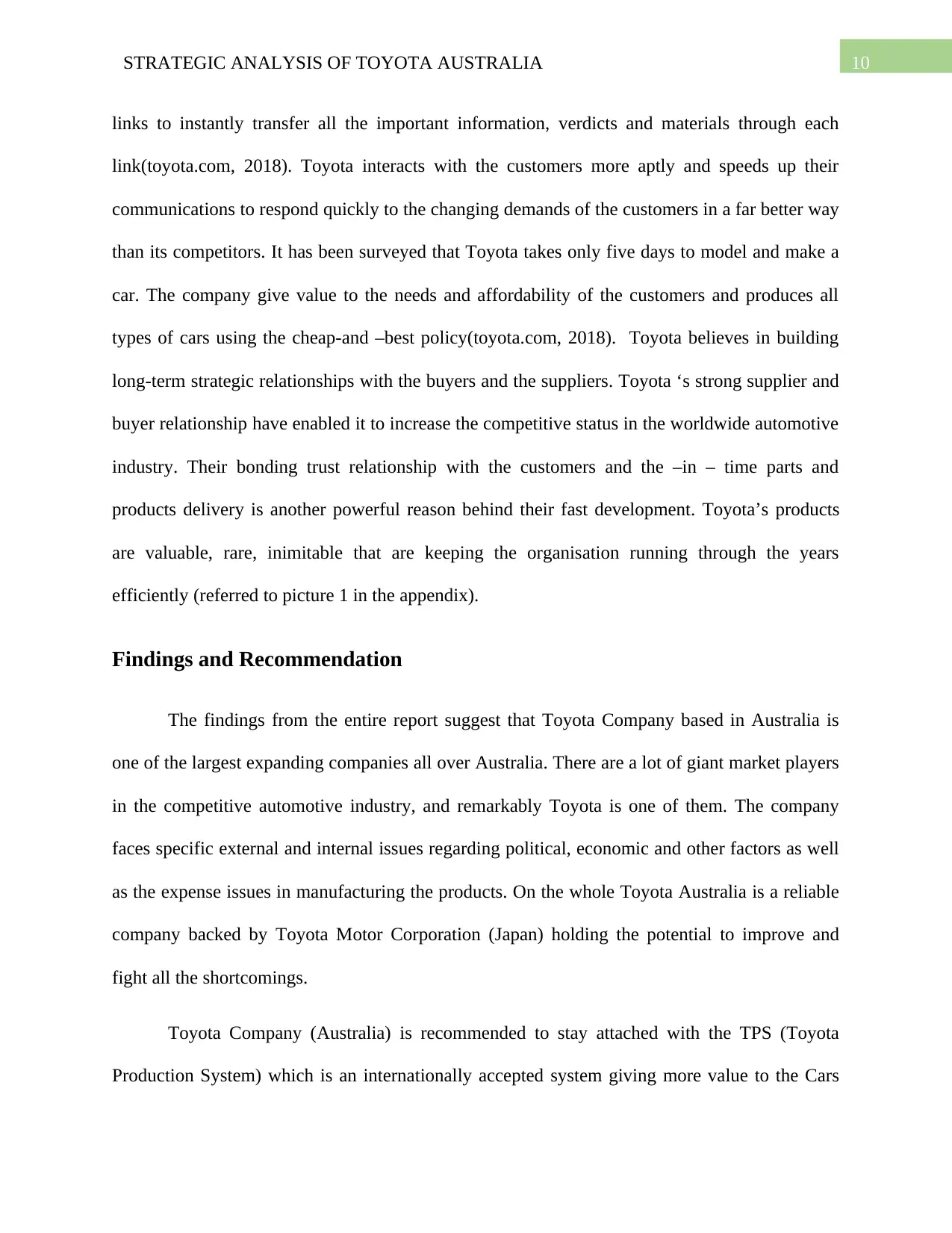
10STRATEGIC ANALYSIS OF TOYOTA AUSTRALIA
links to instantly transfer all the important information, verdicts and materials through each
link(toyota.com, 2018). Toyota interacts with the customers more aptly and speeds up their
communications to respond quickly to the changing demands of the customers in a far better way
than its competitors. It has been surveyed that Toyota takes only five days to model and make a
car. The company give value to the needs and affordability of the customers and produces all
types of cars using the cheap-and –best policy(toyota.com, 2018). Toyota believes in building
long-term strategic relationships with the buyers and the suppliers. Toyota ‘s strong supplier and
buyer relationship have enabled it to increase the competitive status in the worldwide automotive
industry. Their bonding trust relationship with the customers and the –in – time parts and
products delivery is another powerful reason behind their fast development. Toyota’s products
are valuable, rare, inimitable that are keeping the organisation running through the years
efficiently (referred to picture 1 in the appendix).
Findings and Recommendation
The findings from the entire report suggest that Toyota Company based in Australia is
one of the largest expanding companies all over Australia. There are a lot of giant market players
in the competitive automotive industry, and remarkably Toyota is one of them. The company
faces specific external and internal issues regarding political, economic and other factors as well
as the expense issues in manufacturing the products. On the whole Toyota Australia is a reliable
company backed by Toyota Motor Corporation (Japan) holding the potential to improve and
fight all the shortcomings.
Toyota Company (Australia) is recommended to stay attached with the TPS (Toyota
Production System) which is an internationally accepted system giving more value to the Cars
links to instantly transfer all the important information, verdicts and materials through each
link(toyota.com, 2018). Toyota interacts with the customers more aptly and speeds up their
communications to respond quickly to the changing demands of the customers in a far better way
than its competitors. It has been surveyed that Toyota takes only five days to model and make a
car. The company give value to the needs and affordability of the customers and produces all
types of cars using the cheap-and –best policy(toyota.com, 2018). Toyota believes in building
long-term strategic relationships with the buyers and the suppliers. Toyota ‘s strong supplier and
buyer relationship have enabled it to increase the competitive status in the worldwide automotive
industry. Their bonding trust relationship with the customers and the –in – time parts and
products delivery is another powerful reason behind their fast development. Toyota’s products
are valuable, rare, inimitable that are keeping the organisation running through the years
efficiently (referred to picture 1 in the appendix).
Findings and Recommendation
The findings from the entire report suggest that Toyota Company based in Australia is
one of the largest expanding companies all over Australia. There are a lot of giant market players
in the competitive automotive industry, and remarkably Toyota is one of them. The company
faces specific external and internal issues regarding political, economic and other factors as well
as the expense issues in manufacturing the products. On the whole Toyota Australia is a reliable
company backed by Toyota Motor Corporation (Japan) holding the potential to improve and
fight all the shortcomings.
Toyota Company (Australia) is recommended to stay attached with the TPS (Toyota
Production System) which is an internationally accepted system giving more value to the Cars
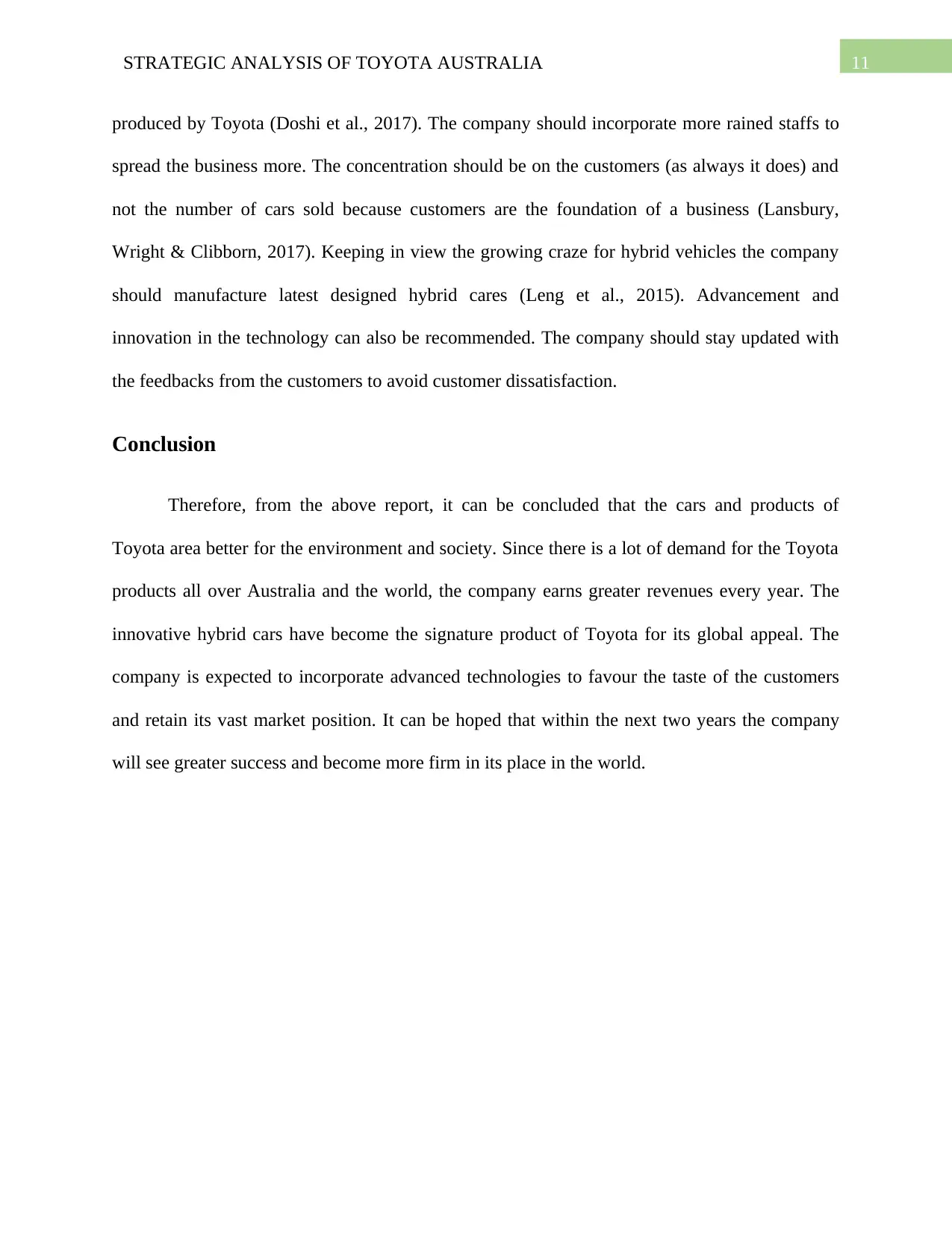
11STRATEGIC ANALYSIS OF TOYOTA AUSTRALIA
produced by Toyota (Doshi et al., 2017). The company should incorporate more rained staffs to
spread the business more. The concentration should be on the customers (as always it does) and
not the number of cars sold because customers are the foundation of a business (Lansbury,
Wright & Clibborn, 2017). Keeping in view the growing craze for hybrid vehicles the company
should manufacture latest designed hybrid cares (Leng et al., 2015). Advancement and
innovation in the technology can also be recommended. The company should stay updated with
the feedbacks from the customers to avoid customer dissatisfaction.
Conclusion
Therefore, from the above report, it can be concluded that the cars and products of
Toyota area better for the environment and society. Since there is a lot of demand for the Toyota
products all over Australia and the world, the company earns greater revenues every year. The
innovative hybrid cars have become the signature product of Toyota for its global appeal. The
company is expected to incorporate advanced technologies to favour the taste of the customers
and retain its vast market position. It can be hoped that within the next two years the company
will see greater success and become more firm in its place in the world.
produced by Toyota (Doshi et al., 2017). The company should incorporate more rained staffs to
spread the business more. The concentration should be on the customers (as always it does) and
not the number of cars sold because customers are the foundation of a business (Lansbury,
Wright & Clibborn, 2017). Keeping in view the growing craze for hybrid vehicles the company
should manufacture latest designed hybrid cares (Leng et al., 2015). Advancement and
innovation in the technology can also be recommended. The company should stay updated with
the feedbacks from the customers to avoid customer dissatisfaction.
Conclusion
Therefore, from the above report, it can be concluded that the cars and products of
Toyota area better for the environment and society. Since there is a lot of demand for the Toyota
products all over Australia and the world, the company earns greater revenues every year. The
innovative hybrid cars have become the signature product of Toyota for its global appeal. The
company is expected to incorporate advanced technologies to favour the taste of the customers
and retain its vast market position. It can be hoped that within the next two years the company
will see greater success and become more firm in its place in the world.
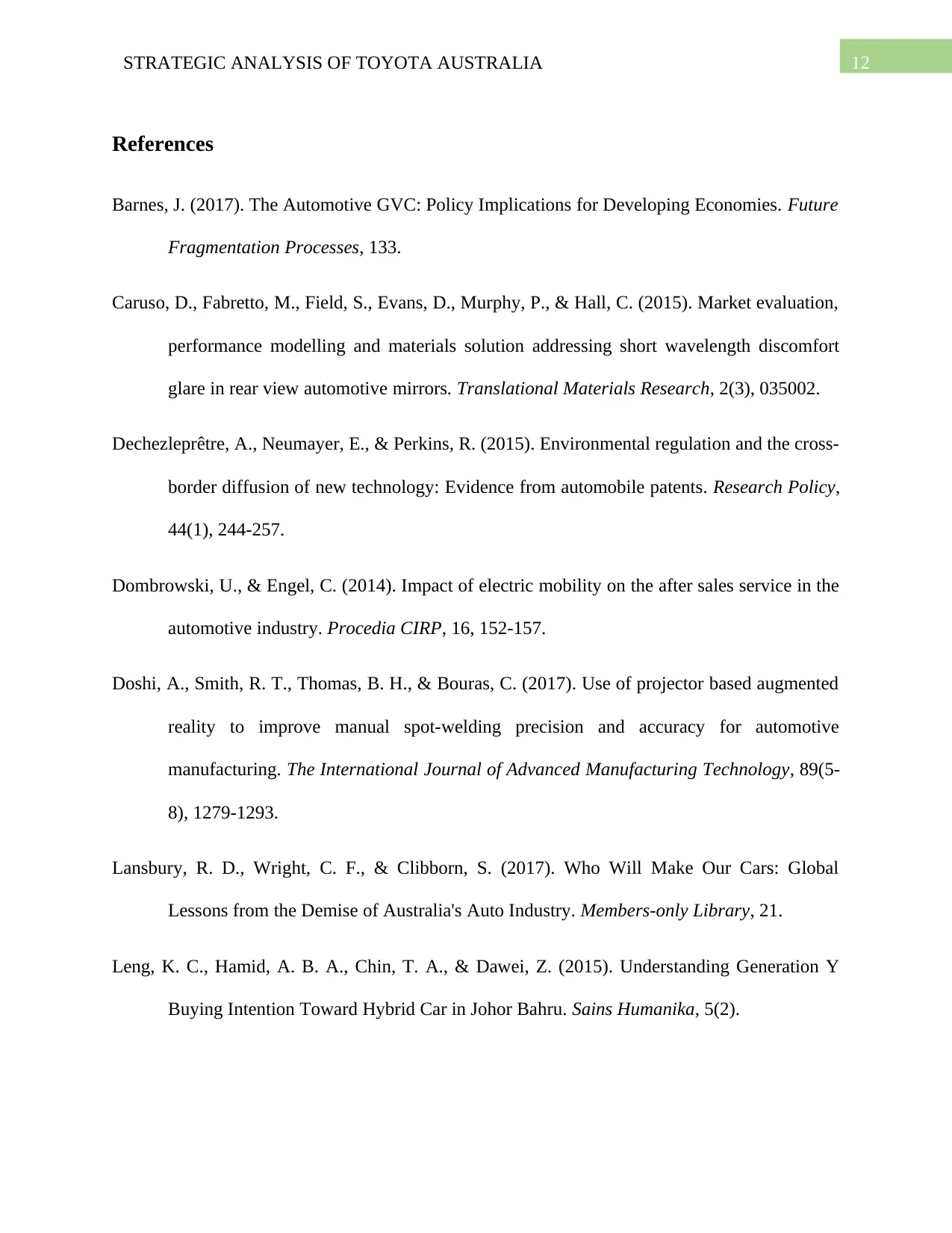
12STRATEGIC ANALYSIS OF TOYOTA AUSTRALIA
References
Barnes, J. (2017). The Automotive GVC: Policy Implications for Developing Economies. Future
Fragmentation Processes, 133.
Caruso, D., Fabretto, M., Field, S., Evans, D., Murphy, P., & Hall, C. (2015). Market evaluation,
performance modelling and materials solution addressing short wavelength discomfort
glare in rear view automotive mirrors. Translational Materials Research, 2(3), 035002.
Dechezleprêtre, A., Neumayer, E., & Perkins, R. (2015). Environmental regulation and the cross-
border diffusion of new technology: Evidence from automobile patents. Research Policy,
44(1), 244-257.
Dombrowski, U., & Engel, C. (2014). Impact of electric mobility on the after sales service in the
automotive industry. Procedia CIRP, 16, 152-157.
Doshi, A., Smith, R. T., Thomas, B. H., & Bouras, C. (2017). Use of projector based augmented
reality to improve manual spot-welding precision and accuracy for automotive
manufacturing. The International Journal of Advanced Manufacturing Technology, 89(5-
8), 1279-1293.
Lansbury, R. D., Wright, C. F., & Clibborn, S. (2017). Who Will Make Our Cars: Global
Lessons from the Demise of Australia's Auto Industry. Members-only Library, 21.
Leng, K. C., Hamid, A. B. A., Chin, T. A., & Dawei, Z. (2015). Understanding Generation Y
Buying Intention Toward Hybrid Car in Johor Bahru. Sains Humanika, 5(2).
References
Barnes, J. (2017). The Automotive GVC: Policy Implications for Developing Economies. Future
Fragmentation Processes, 133.
Caruso, D., Fabretto, M., Field, S., Evans, D., Murphy, P., & Hall, C. (2015). Market evaluation,
performance modelling and materials solution addressing short wavelength discomfort
glare in rear view automotive mirrors. Translational Materials Research, 2(3), 035002.
Dechezleprêtre, A., Neumayer, E., & Perkins, R. (2015). Environmental regulation and the cross-
border diffusion of new technology: Evidence from automobile patents. Research Policy,
44(1), 244-257.
Dombrowski, U., & Engel, C. (2014). Impact of electric mobility on the after sales service in the
automotive industry. Procedia CIRP, 16, 152-157.
Doshi, A., Smith, R. T., Thomas, B. H., & Bouras, C. (2017). Use of projector based augmented
reality to improve manual spot-welding precision and accuracy for automotive
manufacturing. The International Journal of Advanced Manufacturing Technology, 89(5-
8), 1279-1293.
Lansbury, R. D., Wright, C. F., & Clibborn, S. (2017). Who Will Make Our Cars: Global
Lessons from the Demise of Australia's Auto Industry. Members-only Library, 21.
Leng, K. C., Hamid, A. B. A., Chin, T. A., & Dawei, Z. (2015). Understanding Generation Y
Buying Intention Toward Hybrid Car in Johor Bahru. Sains Humanika, 5(2).
Paraphrase This Document
Need a fresh take? Get an instant paraphrase of this document with our AI Paraphraser
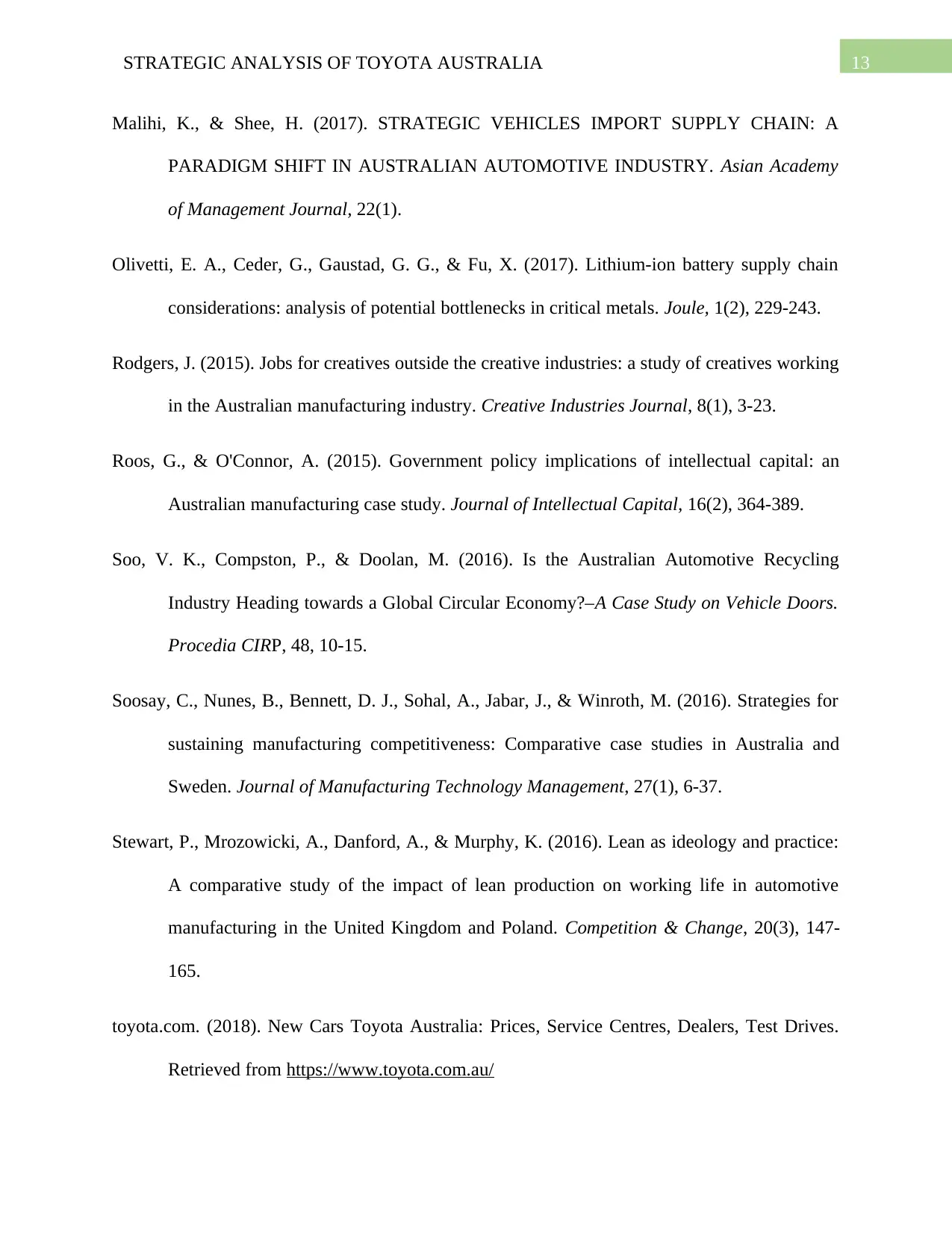
13STRATEGIC ANALYSIS OF TOYOTA AUSTRALIA
Malihi, K., & Shee, H. (2017). STRATEGIC VEHICLES IMPORT SUPPLY CHAIN: A
PARADIGM SHIFT IN AUSTRALIAN AUTOMOTIVE INDUSTRY. Asian Academy
of Management Journal, 22(1).
Olivetti, E. A., Ceder, G., Gaustad, G. G., & Fu, X. (2017). Lithium-ion battery supply chain
considerations: analysis of potential bottlenecks in critical metals. Joule, 1(2), 229-243.
Rodgers, J. (2015). Jobs for creatives outside the creative industries: a study of creatives working
in the Australian manufacturing industry. Creative Industries Journal, 8(1), 3-23.
Roos, G., & O'Connor, A. (2015). Government policy implications of intellectual capital: an
Australian manufacturing case study. Journal of Intellectual Capital, 16(2), 364-389.
Soo, V. K., Compston, P., & Doolan, M. (2016). Is the Australian Automotive Recycling
Industry Heading towards a Global Circular Economy?–A Case Study on Vehicle Doors.
Procedia CIRP, 48, 10-15.
Soosay, C., Nunes, B., Bennett, D. J., Sohal, A., Jabar, J., & Winroth, M. (2016). Strategies for
sustaining manufacturing competitiveness: Comparative case studies in Australia and
Sweden. Journal of Manufacturing Technology Management, 27(1), 6-37.
Stewart, P., Mrozowicki, A., Danford, A., & Murphy, K. (2016). Lean as ideology and practice:
A comparative study of the impact of lean production on working life in automotive
manufacturing in the United Kingdom and Poland. Competition & Change, 20(3), 147-
165.
toyota.com. (2018). New Cars Toyota Australia: Prices, Service Centres, Dealers, Test Drives.
Retrieved from https://www.toyota.com.au/
Malihi, K., & Shee, H. (2017). STRATEGIC VEHICLES IMPORT SUPPLY CHAIN: A
PARADIGM SHIFT IN AUSTRALIAN AUTOMOTIVE INDUSTRY. Asian Academy
of Management Journal, 22(1).
Olivetti, E. A., Ceder, G., Gaustad, G. G., & Fu, X. (2017). Lithium-ion battery supply chain
considerations: analysis of potential bottlenecks in critical metals. Joule, 1(2), 229-243.
Rodgers, J. (2015). Jobs for creatives outside the creative industries: a study of creatives working
in the Australian manufacturing industry. Creative Industries Journal, 8(1), 3-23.
Roos, G., & O'Connor, A. (2015). Government policy implications of intellectual capital: an
Australian manufacturing case study. Journal of Intellectual Capital, 16(2), 364-389.
Soo, V. K., Compston, P., & Doolan, M. (2016). Is the Australian Automotive Recycling
Industry Heading towards a Global Circular Economy?–A Case Study on Vehicle Doors.
Procedia CIRP, 48, 10-15.
Soosay, C., Nunes, B., Bennett, D. J., Sohal, A., Jabar, J., & Winroth, M. (2016). Strategies for
sustaining manufacturing competitiveness: Comparative case studies in Australia and
Sweden. Journal of Manufacturing Technology Management, 27(1), 6-37.
Stewart, P., Mrozowicki, A., Danford, A., & Murphy, K. (2016). Lean as ideology and practice:
A comparative study of the impact of lean production on working life in automotive
manufacturing in the United Kingdom and Poland. Competition & Change, 20(3), 147-
165.
toyota.com. (2018). New Cars Toyota Australia: Prices, Service Centres, Dealers, Test Drives.
Retrieved from https://www.toyota.com.au/
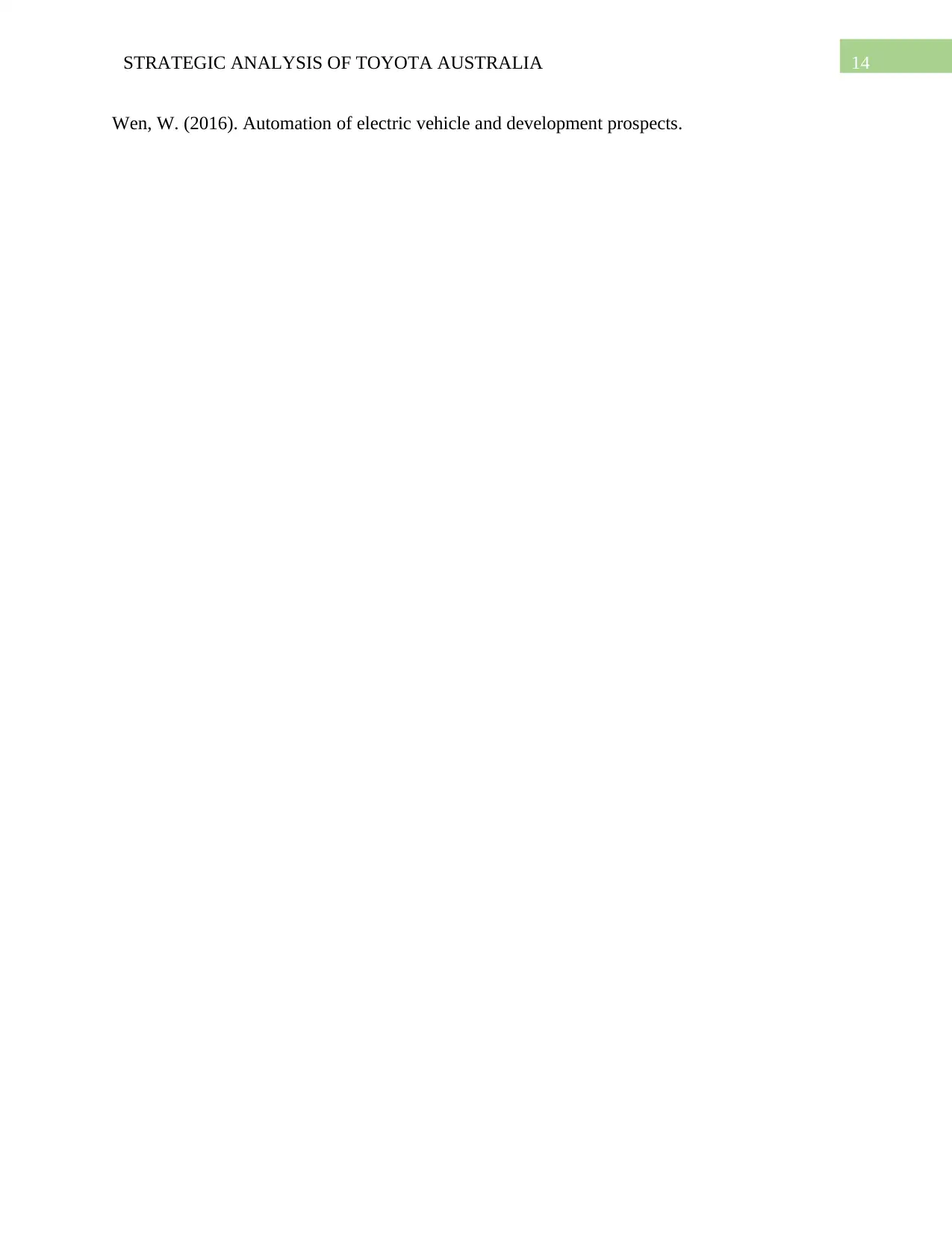
14STRATEGIC ANALYSIS OF TOYOTA AUSTRALIA
Wen, W. (2016). Automation of electric vehicle and development prospects.
Wen, W. (2016). Automation of electric vehicle and development prospects.

15STRATEGIC ANALYSIS OF TOYOTA AUSTRALIA
Appendix
VRIO Analysis of Toyota ( image 1)
Appendix
VRIO Analysis of Toyota ( image 1)
1 out of 16
Related Documents
Your All-in-One AI-Powered Toolkit for Academic Success.
+13062052269
info@desklib.com
Available 24*7 on WhatsApp / Email
![[object Object]](/_next/static/media/star-bottom.7253800d.svg)
Unlock your academic potential
© 2024 | Zucol Services PVT LTD | All rights reserved.





